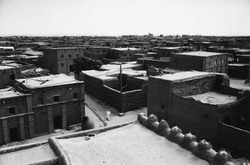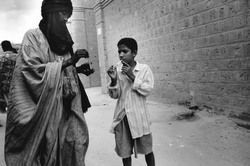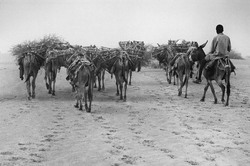Catalogue “Roads to Timbuktu”
Preface by Michael Reinsch
How do you approach a myth or a cliché – how disappointment or hope? This is not a question of the mode of transportation or of cardinal points, even if it concerns a city in the Republic of Mali, with precise coordinates. Certainly, Timbuktu is more than a word.
“The locals of Timbuktu are a happy people, dancing and singing through their town, from the 22nd hour of the day until the first hour of the night” Johann Leo Afrikanus wrote in 1550 – from first hand experience – in his book “Describing Africa”.
Today, there are only a few thousand people living there. Their fertile land dried up; wealth and power turned into misery and hardship.
And yet – just like a dream – the sound of the word “Timbuktu” evokes in our heads images of caravans, of salt and slavery trade, of gold treasures in the palace of the mighty ruler and of the wisdom of learned men at the city’s university.
This is an enormous contrast to the Africa, to the Sahara we see in reality. Do we actually really see Africa? The journey to Timbuktu is arduous.
Mirko Krizanovic undertook the journey – from Burkina Faso, by the way – but that is beside the point. He traveled the African continent from the north to the south, from the west to the east. Reporters like him bring foreign countries closer to us and help us getting to know strangers. We see them in his photographs, through his eyes. Mirko Krizanovic was editorial staff photographer for the Frankfurter Allgemeine Zeitung. He traded this secure position for the freedom, full of risks, of working diligently and not under pressure to meet daily deadlines.
He has changed over the past 5 years. His signature has become more prominent. The reason – seemingly paradoxical – is his ability to allow the subjects of his photos to be true subjects instead of objects of his own viewpoint. The photographer does not determine the image, but the situation does. The more sensitively he works, the more Mirko Krizanovic’s photographs appear raw, sometimes even rough.
The glamour of technical perfection fades away allowing the soul of the moment to appear. No flash brightens the mysterious situation in the interior of a simple building in the Mauritanian Desert and blinds the people who are meeting there. No idle Kodak color attempt to capture any rich color spectrum or constantly changing shade nuances.
Mirko Krizanovic approaches human beings with an attentive eye – either peacefully quiet or with terrifying horror; with utmost caution or with great familiarity.
After all, attentiveness is another word for respect. And like the observant eye that needs all the other senses as well, Mirko Krizanovic opens his camera’s aperture and f-stop wide, to make fast movements blur and contrasts dissolve in the graininess of the manipulated black and white film.
The photographer chooses time and location, the angle and the detail – however, he does not control the scene. For the split second it takes to release, he abolishes the idea of the photograph. Mirko Krizanovic aids this process, to reflect its own image.
“If we were to discover a new world today, would we be able to really see it? Would we be able to abandon from our brain all previous images, normally associated with the expectations of a different world, in order to grasp the different-ness presenting itself before our eyes?” In 1976, Italo Calvino described how explorers of America – which was discovered in the same century as the continent described by Moroccan-born Leo Afrikanus – ignorantly walked by never before seen phenomena.
Their eyes and brains, just like our eyes and brains today, were used to only perceive what fit into their established classification system. “Perhaps a new world opens up before our eyes every day”, Calvino wrote, “and we don’t see it”.
Roads to Timbuktu – how do you distance yourself from something that you carry around in your head? By approaching it.






